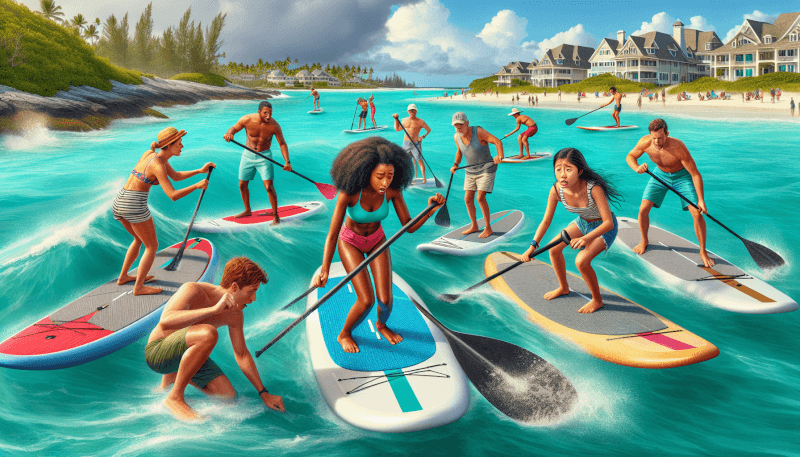So, you’ve decided to embark on a thrilling adventure in the sunny state of Florida and give stand-up paddleboarding a try? You’ve come to the right place! In this beginner’s guide, we’ll take you through everything you need to know to conquer the calm waters of Florida and master the art of paddleboarding. From choosing the perfect location to essential gear and techniques, we’ll equip you with all the knowledge to make your paddleboarding experience unforgettable. So grab your board, get ready to feel the gentle swaying of the waves beneath your feet, and let’s dive into the world of stand-up paddleboarding in Florida!

Places to Paddleboard in Florida
Popular Paddleboarding Spots in Miami
Miami is known for its vibrant beach scene, and it offers some fantastic paddleboarding opportunities. From the iconic South Beach to the picturesque Key Biscayne, Miami’s beaches provide the perfect backdrop for a paddleboarding adventure. The calm and warm waters of the Atlantic Ocean make it an ideal location for beginners and experienced paddlers alike. Additionally, the Miami skyline and beautiful marine life make for a truly memorable experience.
Exploring the Intracoastal Waterway in Fort Lauderdale
Fort Lauderdale is home to the stunning Intracoastal Waterway, a scenic route that stretches for miles and is perfect for paddleboarding. You can explore the waterway and its many canals, taking in the gorgeous waterfront homes and stunning yachts along the way. The calm, flat waters provide an excellent opportunity to practice paddling techniques and enjoy the serene environment. Fort Lauderdale’s warm weather and sunny skies make it an ideal destination for paddleboarding year-round.
Paddleboarding in the Calm Waters of Naples
Naples, located on the Gulf of Mexico, offers paddleboarding enthusiasts a tranquil and picturesque experience. With its calm, crystal-clear waters, Naples provides the perfect setting for beginners looking to learn the sport or for experienced paddlers seeking a relaxing day on the water. You can paddle along the coastline, taking in the breathtaking views or venture out to nearby islands such as Keewaydin Island for a more secluded experience.
Adventures on the Gulf of Mexico in Sarasota
Sarasota is a paradise for paddleboarding enthusiasts with its crystal-clear waters and stunning beaches along the Gulf of Mexico. Whether you’re a beginner or an experienced paddler, Sarasota offers a variety of locations to explore. From paddling through the mangrove tunnels of Lido Key to enjoying the vibrant marine life at Siesta Key, there is something for everyone. The calm and warm waters of the Gulf make Sarasota a popular destination for paddleboarding year-round.
Discovering the Springs in Central Florida
Central Florida is home to numerous freshwater springs, offering a unique paddleboarding experience unlike any other. Places like Blue Springs State Park and Weeki Wachee Springs State Park allow you to paddle in crystal-clear waters surrounded by lush vegetation. You can spot various wildlife like manatees, turtles, and birds as you glide along the peaceful springs. These serene and scenic spots in Central Florida provide an excellent opportunity to connect with nature while enjoying paddleboarding.
Exploring the Mangrove Tunnels in the Florida Keys
The Florida Keys are famous for their beautiful coral reefs and warm turquoise waters. Beyond the stunning beaches, paddleboarding enthusiasts will find an adventure waiting in the mangrove tunnels. Paddling through these intricate and narrow waterways provides a unique and immersive experience. You can witness the diverse marine life thriving in the mangroves, such as tropical fish and vibrant coral formations. The Florida Keys offer a one-of-a-kind paddleboarding experience that combines the beauty of the ocean with the serenity of nature.
Paddleboarding in the Everglades
The Everglades is a vast and ecologically diverse ecosystem that is perfect for adventurous paddleboarders. You can explore the tranquil backwaters, winding channels, and sawgrass marshes while immersing yourself in the beauty of the natural surrounding. Paddleboarding in the Everglades allows you to observe unique flora and fauna, including alligators, turtles, and a variety of bird species. It’s important to be aware of the tides and weather conditions when paddleboarding in the Everglades, as they can affect waterway navigation.
Venturing into the Crystal River
Crystal River is known as the “Home of the Manatees” and offers a truly unforgettable paddleboarding experience. Here, you can paddle alongside these gentle giants in their natural habitat. Crystal River provides a unique opportunity to connect with nature and observe manatees up close. The crystal-clear waters of the river allow for excellent visibility, making it an ideal location for both beginners and experienced paddlers. It’s important to respect the manatees and follow guidelines to ensure their safety and protection.
Exploring the Beautiful Beaches of Sanibel Island
Sanibel Island, located on the Gulf Coast of Florida, is a treasure trove for paddleboarding enthusiasts. With its pristine beaches, calm waters, and diverse wildlife, Sanibel Island offers the perfect setting to enjoy this water sport. You can paddle along the shoreline, exploring the beautiful coastline and keeping an eye out for dolphins and other marine creatures. The island’s seclusion and natural beauty make it a wonderful destination for paddleboarding enthusiasts seeking a peaceful and scenic experience.
Paddleboarding on the St. Johns River
The St. Johns River, one of Florida’s longest rivers, provides a unique paddleboarding experience for nature lovers. You can explore the tranquil waters, surrounded by lush vegetation and abundant wildlife. Paddling on the St. Johns River offers the opportunity to see alligators, turtles, and a variety of bird species up close. The slow-moving current and calm waters make it an excellent location for beginners and those looking for a relaxing paddleboarding experience.
Essential Gear for Stand-Up Paddleboarding
Choosing the Right Paddleboard
When it comes to selecting a paddleboard, it’s important to consider factors such as your skill level, intended use, and personal preference. There are different types of paddleboards, including all-around, touring, and surfing boards. All-around boards are versatile and great for beginners as they offer stability and maneuverability. Touring boards are designed for longer distances and more advanced paddlers, while surfing boards are suitable for those looking to catch waves. Additionally, you’ll want to consider the size, material, and weight capacity of the paddleboard to ensure a comfortable and enjoyable experience.
Paddle Options and Techniques
The paddle is a crucial piece of gear for paddleboarding, and choosing the right one is essential. Paddle length should be determined based on your height and paddling style. The paddle should reach your wrist when standing upright with the blade in the water. There are different paddle materials to choose from, including aluminum, fiberglass, and carbon fiber, each with its own benefits and price range. It’s important to use proper paddle techniques, such as using your core muscles, engaging your whole body, and maintaining a relaxed grip, to optimize your performance and minimize fatigue.
Recommended Safety Gear
Safety should always be a top priority when paddleboarding, and there are several essential items that every paddler should have. A properly-fitted personal flotation device (PFD) is crucial for ensuring your safety while on the water. It’s also recommended to wear a leash that attaches you to the paddleboard, as it can prevent you from getting separated from your board in case of a fall or strong current. Other safety gear includes a whistle for signaling in case of an emergency, a waterproof first aid kit, and a communication device to reach out for help if needed.
Proper Clothing for Paddleboarding
Choosing the right clothing for paddleboarding is important for both comfort and safety. It’s advisable to wear a bathing suit, board shorts, or a rash guard to allow freedom of movement while paddleboarding. Additionally, it’s important to protect yourself from the sun by wearing a wide-brimmed hat, sunglasses with UV protection, and sunscreen with a high SPF. Water shoes are also recommended to protect your feet from hot sand, rocks, or sharp objects in the water.
Accessories for Convenience and Comfort
There are various accessories available to enhance your paddleboarding experience. A dry bag or waterproof phone case can keep your belongings safe and dry while out on the water. A deck bag or bungee cords can secure items like water bottles, snacks, and extra layers of clothing. A waterproof watch or fitness tracker can help you keep track of time or monitor your paddling performance. Lastly, a waterproof camera or GoPro can capture your paddleboarding adventures, allowing you to relive the memories for years to come.

Basic Stand-Up Paddleboarding Techniques
Finding Your Balance on the Board
Finding your balance on the paddleboard is crucial for a successful and enjoyable experience. Start by positioning yourself in the center of the board, with your feet shoulder-width apart. Engage your core muscles to maintain stability and keep a relaxed stance. Practice distributing your weight evenly and making small adjustments to maintain balance. It may take some time to find your balance, especially if you’re a beginner, but with practice, you’ll become more comfortable and confident on the board.
Proper Paddle Grip and Strokes
Having the correct paddle grip and using proper paddle strokes is essential for efficient and effective paddling. Place one hand on the top of the paddle grip and the other hand on the shaft, shoulder-width apart. Use a relaxed grip and avoid gripping too tightly. To paddle, engage your core muscles and push the blade into the water, making sure to fully submerge it. Pull the paddle back towards you, keeping it close to the side of the board, and repeat the motion on the opposite side. Make sure to paddle evenly on both sides to maintain balance and prevent muscle fatigue.
Correct Stance and Posture
Maintaining a correct stance and posture while paddleboarding is important for efficiency and minimizing strain on your body. Stand upright with your knees slightly bent and your back straight. Avoid hunching over or leaning too far forward or backward. Keep your gaze forward and your shoulders relaxed. Engage your core muscles to stabilize your body and maintain a proper alignment. By adopting the correct stance and posture, you’ll be able to paddle effectively and prevent unnecessary strain on your muscles.
Navigating Different Water Conditions
As a paddleboarder, it’s essential to be able to navigate different water conditions effectively. Calm and flat waters are best for beginners as they provide a stable and predictable surface. When encountering small waves, it’s important to approach them at an angle and use your core muscles to maintain stability. In choppy or windy conditions, bending your knees slightly and keeping a lower center of gravity can help maintain balance. Remember to always assess the water conditions before heading out and adjust your technique accordingly for a safe and enjoyable paddleboarding experience.
Steering and Turning Techniques
Steering and turning are essential skills in paddleboarding, allowing you to navigate and maneuver on the water. To steer, you can use a sweep stroke by extending the paddle out to one side of the board and sweeping it towards the rear, creating a sweeping motion. To turn, you can use a combination of forward and backward strokes on one side of the board. For sharper turns, you can step back on the board and use a quick backstroke to pivot. Practice these techniques in different water conditions to become more skilled at steering and turning your paddleboard.
Safety Tips for Stand-Up Paddleboarding
Understanding Weather Conditions and Tides
Before heading out for a paddleboarding session, it’s essential to understand the current weather conditions and tides. Check the forecast for wind speed, wave height, and any upcoming storm systems. High winds and rough water can make paddleboarding challenging and dangerous. Similarly, knowledge of tidal patterns is crucial, as strong currents caused by tides can affect your ability to paddle and navigate. Always choose calm and favorable weather conditions to ensure a safe and enjoyable paddleboarding experience.
Using Buoyancy Aids and Leashes
Using buoyancy aids, such as a personal flotation device (PFD), is essential for safety while paddleboarding. A PFD will help you stay afloat in case of an accidental fall or fatigue. It’s important to choose a PFD that provides a comfortable fit and is approved by relevant safety authorities. Additionally, wearing a leash that attaches you to the paddleboard is recommended as it keeps you connected to your board, especially in case of falls or strong currents. Remember to always wear your PFD and leash properly and ensure they are in good working condition before heading out on the water.
Knowing Your Limits and Staying Close to Shore
It’s important to know your personal limits and paddle within your comfort zone. If you’re a beginner, it’s advisable to start in calm and sheltered areas where you can practice your skills and build your confidence. Stay close to the shore, within easy reach of safety, especially when you’re still learning. As you gain experience and proficiency, you can gradually explore farther distances and more challenging waters. However, it’s important to always be aware of your limits and avoid getting too far from shore or venturing into hazardous conditions.
Avoiding Areas with Strong Currents or Wildlife
When paddleboarding, it’s important to be mindful of areas with strong currents or wildlife. Strong currents can be challenging to paddle against and may cause fatigue or make it difficult to return to shore. Be aware of any posted warnings or local advisories about currents or hazardous areas. Additionally, it’s crucial to respect wildlife and their habitats. Avoid disturbing or approaching wildlife too closely and be conscious of any protected areas or nesting sites. By avoiding areas with strong currents or wildlife, you can ensure both your safety and the preservation of the natural environment.
Using Proper Etiquette and Respecting Others
When paddleboarding, it’s important to follow proper etiquette and be respectful of others sharing the water. Always be mindful of other paddlers, boaters, and swimmers around you. Give them plenty of space and avoid creating wakes or splashing excessively. Yield to vessels with the right of way and be aware of any posted rules or regulations specific to the area you’re paddling in. Additionally, it’s important to properly dispose of any trash or waste to help keep the waterways clean and protect the environment for everyone to enjoy.

Choosing the Right Paddleboarding Equipment Rental
Considering Board Size and Type
When choosing a paddleboarding equipment rental, consider the size and type of board that suits your needs and skill level. If you’re a beginner or prefer stability, an all-around board with a larger volume and width is a good choice. Intermediate or advanced paddlers may opt for touring or surfing boards that offer better performance and maneuverability. It’s important to communicate your skill level and preferences to the rental shop to ensure you get the right board for your paddleboarding experience.
Quality and Condition of the Equipment
Ensure that the paddleboarding equipment you rent is of good quality and in good condition. Check the board for any damages, such as cracks or delamination, which can affect its performance and safety. The paddle should be adjustable and in good working condition, with no signs of wear or damage. Take the time to inspect the leash and PFD to ensure they are in proper working order. If you notice any issues with the rental equipment, inform the rental shop immediately to avoid any accidents or inconvenience.
Availability and Rates of Rental Shops
Consider the availability and rates of different paddleboarding equipment rental shops in the area you plan to visit. Check their operating hours and make reservations in advance if possible, especially during peak seasons when rentals may be in high demand. Compare rental rates to ensure you’re getting a fair price for the equipment and services provided. Additionally, read reviews or ask for recommendations from fellow paddleboarders to ensure you choose a reputable and reliable rental shop.
Additional Services and Packages
Some paddleboarding equipment rental shops may offer additional services or packages that can enhance your paddleboarding experience. These services can include guided tours, lessons, or equipment delivery to your desired location. Packages may include multiple rental days or combine equipment rental with other activities or amenities. Consider your preferences and budget when choosing a rental shop and inquire about any additional services or packages that may be available to maximize your paddleboarding adventure.
Popular Paddleboarding Tours and Classes
Guided Eco-Tours in the Everglades
Exploring the Everglades on a guided eco-tour is a fantastic way to experience the unique beauty and wildlife of this iconic national park. Guided eco-tours can take you deep into the heart of the Everglades, where you can paddle through mangrove tunnels, observe diverse flora and fauna, and learn about the importance of this fragile ecosystem. Expert guides provide valuable insights and ensure your safety while giving you the opportunity to connect with nature and gain a deeper understanding of the Everglades.
Sunset Paddleboarding Experiences
Sunset paddleboarding experiences offer a magical way to enjoy Florida’s stunning coastal scenery and vibrant sunsets. Paddleboarding during sunset allows you to witness the sky transform into a panoramic display of colors while gliding peacefully on calm waters. Some tour operators offer guided sunset paddleboarding experiences, where you can paddle along scenic routes or watch the sunset from unique vantage points. These experiences create unforgettable memories and provide a peaceful and reflective way to end the day.
Group Classes for Beginners
Group paddleboarding classes are an excellent option for beginners looking to learn the basics of paddleboarding in a supportive and social environment. These classes typically cover essential techniques, safety guidelines, and proper equipment usage. Certified instructors guide participants through hands-on activities and provide personalized feedback to help improve skills. Group classes offer a fun and interactive way to learn paddleboarding while connecting with others who share a passion for this water sport.
Yoga and Fitness Paddleboarding Classes
Yoga and fitness paddleboarding classes combine the benefits of paddleboarding with the mindfulness and physical activity of yoga and fitness training. These classes take place on calm waters, allowing participants to practice yoga poses or engage in fitness exercises while floating on their paddleboards. Yoga paddleboarding classes often focus on balance, core strength, and flexibility, while fitness paddleboarding classes incorporate cardio and strength training exercises. These classes provide a unique and invigorating way to connect with your body and surroundings.

Benefits of Stand-Up Paddleboarding
Physical and Mental Health Benefits
Stand-up paddleboarding offers numerous physical health benefits. It provides a full-body workout that engages muscle groups such as the core, arms, back, and legs. The constant balancing and paddling motions improve balance, coordination, and overall strength. Paddleboarding also provides cardiovascular exercise, helping to improve stamina and burn calories. Additionally, spending time on the water and connecting with nature has positive effects on mental health, reducing stress, and promoting relaxation.
Low-Impact Full-Body Workout
One of the great advantages of stand-up paddleboarding is that it offers a low-impact full-body workout. Unlike high-impact activities like running or weightlifting, paddleboarding puts minimal stress on the joints, making it accessible to people of various fitness levels and ages. The paddling motion engages your upper body, particularly the arms, shoulders, and core. Meanwhile, the constant balancing and leg movements strengthen your lower body muscles. Paddleboarding allows you to exercise your entire body while enjoying the beauty of the water.
Connecting with Nature and Wildlife
Stand-up paddleboarding provides a unique opportunity to connect with nature and appreciate the natural beauty of Florida’s waterways. Whether cruising along the beach, exploring mangrove tunnels, or paddling through springs, you’ll have the chance to observe and appreciate the diverse wildlife, pristine landscapes, and serene environments that surround you. Paddleboarding gives you a front-row seat to enjoy the sights and sounds of nature, fostering a deeper connection with the natural world.
Opportunities for Socializing and Meeting Others
Paddleboarding is a social activity that offers opportunities to meet like-minded individuals and connect with others who share a love for the water. Joining group classes, tours, or paddleboarding events creates a sense of community and allows you to bond with fellow paddleboarders. Sharing the experience of gliding across the water, exploring new locations, and celebrating achievements promotes camaraderie and friendship. Paddleboarding can be a great way to meet new people and build lasting relationships.
Best Time of Year for Paddleboarding in Florida
Considering Weather and Water Conditions
The best time of year for paddleboarding in Florida depends on various factors, including weather and water conditions. Generally, Florida offers favorable paddleboarding conditions year-round due to its warm climate. However, some seasons may be more ideal than others. Spring and fall are considered optimal as the weather is typically pleasant, with milder temperatures and lower humidity levels. Summer can be hot and humid, but early mornings or evenings can provide cooler and less crowded paddleboarding conditions. Winter in Florida is generally mild, but air and water temperatures may require additional layers of clothing or wetsuits.
Avoiding Crowded Tourist Seasons
Florida is a popular tourist destination, and certain times of the year can be crowded with visitors. Avoiding peak tourist seasons, such as spring break and summer vacation, can ensure a more peaceful and enjoyable paddleboarding experience. During these periods, popular paddleboarding spots may be crowded, and it’s advisable to plan your outings during weekdays or non-peak hours. Choosing less popular locations or exploring off-the-beaten-path areas can also provide a quieter and more serene paddleboarding experience.
Taking Advantage of Off-Peak Discounts
Off-peak seasons, often referred to as shoulder seasons, offer the opportunity to take advantage of discounted rates and special offers. Many paddleboarding rental shops and tour operators offer reduced rates or promotions during these periods to attract customers. By planning your paddleboarding trips during off-peak times, you can save money and enjoy the sport without the hustle and bustle of peak tourist seasons. Check with local rental shops and tour operators to see if any special deals or discounts are available.

Paddleboarding Etiquette and Rules
Understanding Right-of-Way Rules
Understanding and following right-of-way rules is crucial when paddleboarding to maintain safety and avoid collisions with other water users. Generally, paddleboarders should yield to vessels under power, such as motorboats and sailboats. Paddleboarders should also give way to smaller vessels, such as kayaks and canoes. Paddleboarders should be mindful of their surroundings, look out for other watercraft, and maintain a safe distance when sharing the waterways. It’s important to familiarize yourself with local regulations and any specific rules established in the areas where you plan to paddleboard.
Respecting Wildlife and Protected Areas
Respecting wildlife and protected areas is essential for preserving the natural environment and ensuring the well-being of the ecosystem. When paddleboarding, observe wildlife from a respectful distance to avoid causing stress or disturbance. Avoid venturing into protected areas or areas with nesting or breeding sites to allow the wildlife to remain undisturbed. Take care not to disrupt or damage underwater habitats, such as coral reefs or seagrass beds. By following these guidelines, you can contribute to the conservation efforts and maintain the beauty and integrity of Florida’s waterways.
Avoiding Excessive Noise and Disturbances
When paddleboarding, it’s important to avoid excessive noise and disturbances that can disrupt the tranquility of the waterways and disturb wildlife. Keep conversations and noise levels to a minimum, especially in areas known for their serenity or where wildlife is present. Be mindful of your paddle strokes to minimize splashing or creating wakes that can disturb other water users. By maintaining a respectful and quiet presence on the water, you can enhance your own experience and allow others to enjoy the peacefulness of the surroundings.
Properly Disposing of Trash
Properly disposing of trash is essential for keeping Florida’s waterways clean and protecting the environment. Never throw any trash or litter into the water, and always pack out any garbage you generate during your paddleboarding outings. Bring a waterproof bag to collect your trash and dispose of it properly in designated bins or recycling stations. It’s important to leave the waterways as pristine as when you found them, ensuring a clean and enjoyable experience for future paddlers.
Popular Paddleboarding Events and Competitions
Florida Cup Paddleboarding Race
The Florida Cup Paddleboarding Race is an annual event that draws paddleboarding enthusiasts from around the world. Held in various locations in Florida, such as Miami or Fort Lauderdale, the race offers different categories and distances to accommodate paddlers of different skill levels. Participants can test their speed and endurance while enjoying a fun and competitive atmosphere. The Florida Cup is not only a race but also a celebration of the paddleboarding community, bringing together paddlers to share their passion for the sport.
The Great Miami SUP Challenge
The Great Miami SUP Challenge is another exciting paddleboarding event held annually in Miami. This event features a variety of races, including short sprints, distance races, and team relays. Paddleboarders of all ages and skill levels can join in the competitive spirit and enjoy the vibrant atmosphere. The Great Miami SUP Challenge showcases the beauty of Miami’s waterways while promoting the sport and fostering a sense of community among paddleboarding enthusiasts.
Turtle Paddle for a Cause
The Turtle Paddle for a Cause is a unique paddleboarding event that combines paddling with a charitable cause. Organized to raise awareness and funds for sea turtle conservation, this event invites paddleboarders to paddle together along a designated route while learning about sea turtles and their habitats. Participants can contribute to the protection and preservation of these magnificent creatures while enjoying a memorable paddleboarding experience.
SUP Downwind Dash
The SUP Downwind Dash is an exhilarating downwind race held in Florida that challenges paddlers to ride the wind and waves on their stand-up paddleboards. Participants navigate through a designated course, utilizing wind and swells to propel them forward. This event is perfect for experienced paddlers seeking a thrilling and competitive experience. The SUP Downwind Dash showcases the skill and agility of paddleboarders as they harness the elements to race across the water.
Stand-Up Paddleboarding (SUP) in Florida offers a wide range of exciting possibilities for both beginners and experienced paddlers. With its warm climate, diverse waterways, and stunning natural beauty, Florida is a paddleboarding paradise. From exploring the mangrove tunnels in the Florida Keys to paddling in the serene springs of Central Florida, there is something to suit every preference and skill level. With the right gear, techniques, and safety precautions, you can embark on a paddleboarding adventure that connects you with nature, provides a full-body workout, and allows you to create lasting memories. So grab your paddleboard, head to one of Florida’s beautiful locations, and enjoy the thrill and tranquility of stand-up paddleboarding.


